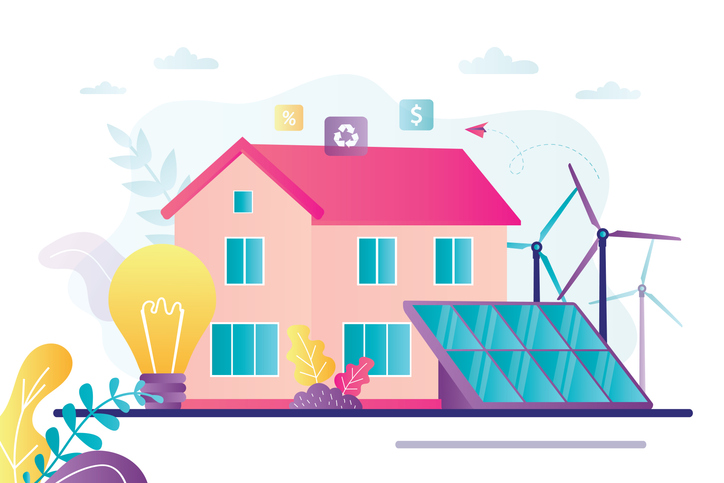By Brentnie Daggett, Rentec Direct
Trends in real estate come and go, but embracing environmentally friendly living at home is one trend that is here to stay. Once considered a “nice-to-have” feature, sustainable home upgrades have become a defining priority for today’s homeowners as they set out to lower their environmental impact. Nearly 70 percent of Millenials and Gen Z are willing to pay more upfront for sustainable homes with features like energy efficiency, electrification, water conservation and solar energy. National sales data confirms this growing demand, showing that energy-efficient homes earn resale values up to five percent higher than less efficient homes.
Ready to cut your utility bills, reduce your carbon footprint, and boost your home’s value? Here are six impactful upgrades you should consider.
Easy: LED Lighting
Switching to LED lighting throughout your home is one of the easiest and most effective ways to reduce utility costs and improve energy efficiency. LED bulbs use 90% less energy and last 25 times longer than traditional bulbs, saving homeowners hundreds of dollars on annual electricity costs. You’ll see an especially significant impact when replacing lights that are often left on for long periods, like outdoor flood lights or office lamps.
The cost of LEDs may be slightly higher than traditional bulbs, so consider replacing light bulbs gradually as they burn out to make the switch more budget-friendly. If you already have a smart home system, consider pairing LEDs with smart light fixtures and bulbs, which offer built-in automation and sensors, for added efficiency.
Easy: Sustainable Landscaping
Landscaping that incorporates native, drought-tolerant plants and features like rain gardens can make a big sustainability impact. Sustainable landscaping supports your local ecosystem and typically requires less water to maintain, which will lower both your utility bill and your carbon footprint. Pollinator-friendly landscaping goes hand-in-hand with native landscaping, which supports the pollinators that are essential to our ecosystem.
As natural disasters become more frequent, insurance companies are increasingly valuing homes with sustainable landscaping as lower risk. For example, utilizing fire-resistant plants in wildfire-prone areas can help to reduce the risk of wildfire spreading through residential areas.
Moderate: Energy-Efficient Appliances
Upgrading to ENERGY STAR-certified appliances is a smart way to reduce energy use and lower your energy bills without sacrificing performance or quality. These energy-efficient appliances, including dishwashers, washing machines, refrigerators, ceiling fans, and more, are specifically designed to meet strict standards set by the Environmental Protection Agency and the U.S. Department of Energy. By choosing ENERGY STAR models next time an appliance needs upgrading or replacing, you’ll be creating a more sustainable living environment.
When replacing or upgrading other home fixtures, consider water-saving options like low-flow toilets, shower heads and faucets. These upgrades will limit your household water consumption and lower your water bills, which means a greener and more cost-effective home.
Moderate: Solar Energy
Investing in solar energy can be a smart financial and environmental choice, leading to extreme savings on energy costs over time. Exact savings vary based on location and electricity costs, but the average homeowner will save $50,000 over 25 years after installing solar panels—and many state governments and utility companies offer rewarding incentives and tax credits for solar installation. If you’re not in your forever home, every dollar saved on electricity costs after installing solar adds $20 of value to your home, with homes with solar systems installed selling for an average of four percent higher than homes without.
Challenging: Clean Heating and Cooling
Your heating, ventilation and air conditioning (HVAC) system accounts for close to 50 percent of your home’s total energy use. Upgrading to a more energy-efficient heating and cooling system can lead to massive energy savings and added home value. HVAC systems are rated based on their energy efficiency, so do your research to find the best option for your unique home. If your home is a candidate, heat pumps are growing in popularity as they can reduce electricity use for heating by up to 75 percent.
Challenging: Green Roofing
The roof condition is a major selling point of a home, and a roof upgraded with eco-friendly materials is an even bigger selling point. As sustainable building materials become more widely available, roofs made of materials that reflect and/or ventilate heat can reduce energy consumption by resisting dramatic heat gain or loss. If your roof is need of replacement, opt for options like metal, wood shingles, clay or slate tiles, or even solar roofing. Living roofs are even gaining popularity, especially in cities, which turns the top of your house into a living garden!
The Inflation Reduction Act
If you have debated any eco-friendly home upgrades in the past, now is an opportune time to make changes with the recently passed Inflation Reduction Act (IRA). The IRA is designed to offer funding to help homeowners reduce energy costs and install clean energy systems, incentivizing with rebates and tax credits to make clean energy upgrades more accessible and affordable. The new law includes incentives for energy-efficient appliances and systems, electric vehicles and solar technology.
Brentnie Daggett is a writer and infographic master for the rental and property management industry. She loves to share tips and tricks to assist landlords and renters alike. To learn more about Daggett, and to discover more great tips for renters, visit www.rentecdirect.com.








